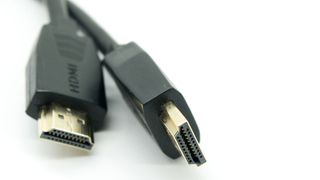You can get away with most any kind of HDMI cable for home use, but with a little knowledge it’s possible to get better performance by using the right HDMI cable for a specific task. Given the investment we now put into our home entertainment systems, it’s also reassuring to know that HDMI cables are relatively inexpensive and most do the job they’re intended for more than adequately. We’ll take a closer look at whether all HDMI cables are the same, and elsewhere at Top Ten Reviews we’ve explored the best HDMI cables (opens in new tab) and examined how do HDMI cables work (opens in new tab)?
What are the different type of HDMI cables?
While most HDMI cables perform the same function, there are different HDMI standards that differentiate them. These standards are defined by the HDMI Licensing Administration and establish universal specifications for manufacturers to follow. Such standards are usually displayed on the packaging of HDMI cables. So you might see a cable displayed as an HDMI 1.4, and HDMI 1.4b, and HDMI 2.0b or, the most recent, HDMI 2.2a. These standards identify when the HDMI specification the cable uses was released but, to be honest, they matter little to the average consumer. An HDMI 1.4b cable, released in 2009, will still run 4K on modern systems as a more contemporary standard, but perhaps at a lower frame rate of around 24FPS.
What are HDMI cable speeds?
Of more significance to most users are cable speeds. Most HDMI cables intended for home theaters fall into one of four categories:
Standard speedHigh speedPremium high-speedUltra-high speed
The slowest of HDMI cables, measured in Gbps (Gigabytes per Second), Standard speed HDMI cables are best suited for resolutions of 1080p. Since 1080p has been superseded by higher resolutions such as 1440p and 4k, standard speed HDMI cables, while cheap, are harder to come by. More common are High-speed HDMI cables which can carry twice the bandwidth of Standard HDMI cables – which is plenty fast enough for 4K. Although more expensive, Premium high-speed and Ultra-high-speed HDMI cables can handle data transfers even higher than 4K. While that might seem impressive, few devices currently operate at resolutions higher than 4K, so these might be overkill for most peoples’ needs but could be a good choice if you want to ‘future-proof’ your home theater setup for the arrival of 8K.
Are HDMI cables all the same?
So, are HDMI cables all the same? Despite the variety of standards and specifications available, the only metric that should matter to most people is cable speed, which makes choosing the right cable for your needs a relatively simple matter. You won’t go terribly wrong with a simple High-speed HDMI cable for most uses, but if you’d like to invest in the best cables for the arrival of the next standards in home theater technology, then Premium high-speed and Ultra-high speed HDMI cables could well pay off down the road. Discover more tech guides… Best tv (opens in new tab) Best HDMI switchers (opens in new tab) Best wireless routers (opens in new tab)







